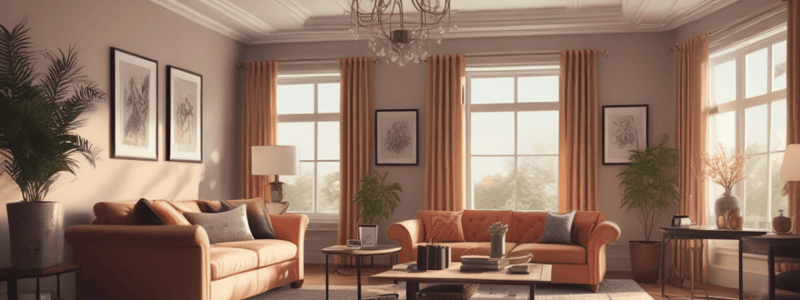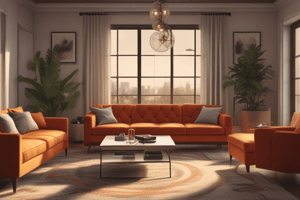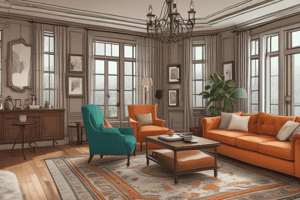Podcast
Questions and Answers
What has become a valuable currency according to Faith Popcorn?
What has become a valuable currency according to Faith Popcorn?
- Skill
- Money
- Experience
- Time (correct)
What is a common characteristic of clients who seek services from interior decorators?
What is a common characteristic of clients who seek services from interior decorators?
- They have no specific preferences.
- They are generally affluent individuals. (correct)
- They are always from low-income backgrounds.
- They require extensive renovations.
What potential income can an interior decorator's own business yield annually?
What potential income can an interior decorator's own business yield annually?
- $100,000 (correct)
- $150,000
- $50,000
- $75,000
What is one significant advantage of starting your own interior decorating business?
What is one significant advantage of starting your own interior decorating business?
What is NOT required to enter the field of interior decorating?
What is NOT required to enter the field of interior decorating?
What is the primary goal of achieving balance in interior design?
What is the primary goal of achieving balance in interior design?
Which of the following best describes asymmetrical balance in interior design?
Which of the following best describes asymmetrical balance in interior design?
What is an effective way to enhance symmetry in a room?
What is an effective way to enhance symmetry in a room?
How can small accessories influence the overall balance of a room?
How can small accessories influence the overall balance of a room?
Why is it important to synchronize colors, textures, and patterns in interior design?
Why is it important to synchronize colors, textures, and patterns in interior design?
What type of balance involves placing identical items on opposite sides of a space?
What type of balance involves placing identical items on opposite sides of a space?
Which arrangement is an example of achieving asymmetrical balance?
Which arrangement is an example of achieving asymmetrical balance?
How can a large painting on one side of a room be effectively balanced?
How can a large painting on one side of a room be effectively balanced?
What role does symmetry play in interior design?
What role does symmetry play in interior design?
What is essential for creating a harmonious composition above a fireplace?
What is essential for creating a harmonious composition above a fireplace?
What impact does symmetrical balance have on the atmosphere of a room?
What impact does symmetrical balance have on the atmosphere of a room?
Which arrangement best illustrates the concept of asymmetrical balance?
Which arrangement best illustrates the concept of asymmetrical balance?
What role do small details play in achieving balance in a room?
What role do small details play in achieving balance in a room?
In what way can positioning substantial items assist in maintaining balance?
In what way can positioning substantial items assist in maintaining balance?
How does effective color synchronization contribute to interior design?
How does effective color synchronization contribute to interior design?
What is the effect of placing identical items on opposite sides of a space in interior design?
What is the effect of placing identical items on opposite sides of a space in interior design?
How can asymmetrical balance enhance the ambiance of a room?
How can asymmetrical balance enhance the ambiance of a room?
Which approach can significantly enhance a room's equilibrium?
Which approach can significantly enhance a room's equilibrium?
What should be considered when positioning accessories near larger decorative items?
What should be considered when positioning accessories near larger decorative items?
In creating a unified space, which factors are crucial to balance effectively?
In creating a unified space, which factors are crucial to balance effectively?
Flashcards are hidden until you start studying
Study Notes
Advantages of Being an Interior Decorator
-
Exciting Work Environment
- Engaging work dynamic fueled by creative challenges across diverse projects.
- Opportunities to design various spaces, from residential to commercial settings.
-
Personal Satisfaction and Fulfillment
- Ability to channel creativity into tangible design outcomes.
- Profound joy in transforming spaces and making a positive impact on clients' lives, such as creating functional and harmonious kitchens.
-
Growing Industry Opportunities
- The interior decorating industry is valued in billions and shows consistent growth.
- Increasing demand as people seek professionals to enhance their living spaces, reflecting personal tastes and lifestyles.
-
Diverse Clientele Interaction
- Opportunity to work with a range of affluent clients, often in exquisite homes.
- Services provided cater to busy individuals seeking aesthetically pleasing and functional spaces tailored to their unique preferences.
-
Lucrative Income Potential
- Potential earnings can exceed $100,000 per year for independent decorators.
- Access to discounts on materials boosts financial stability and facilitates business expansion.
-
Freedom and Autonomy
- Independence in managing your own business and setting a flexible schedule.
- Ability to choose projects that inspire passion and creativity, fostering job satisfaction.
-
Accessible Career Path
- No specialized education or experience is necessary to enter the profession.
- Guides available to help educate, establish networks, and gain experience in the industry.
-
Focus on Learning and Growth
- Emphasis on continuous learning and personal development in every project undertaken.
- Each project represents a new opportunity for creativity and professional growth.
Essential Equipment for Decorating
- Paint chip fan deck provides a wide range of color options for selection.
- Color wheel aids in understanding color relationships and schemes.
- Various manufacturers' catalogs offer inspiration and information on products.
- A selection of papers, including plain and graph paper, is useful for sketches and plans.
- Essential writing tools include pencils for drafting and pens for finalized notes.
- Measuring tools comprise sturdy metal tape (at least 25') and flexible cloth tape for accurate dimensions.
- A range of rulers, including scale and straight-edge types, is necessary for precision in drawing.
- A calculator can assist in computations for material costs and measurements.
- Furniture templates help visualize space layout and furniture arrangement.
- Fabric swatches and flooring samples allow for material selection in the design process.
- Additional tools include a laser measuring tool for precision, various paintbrushes and rollers for painting projects, and a spirit level for hanging elements accurately.
Organizational Strategies
- Use storage containers to keep small hardware items organized and easily accessible.
- Labeling containers helps streamline the crafting and decorating process for quicker retrieval.
- Create a mood board with diverse swatches and clippings for design direction and inspiration.
- Regular visits to art galleries and home decor stores can provide insight into current trends.
Functional Enhancements
- Felt furniture protectors prevent floor damage, safeguarding against scratches from legs of tables and chairs.
- Transparent plastic protectors help shield furniture and assist in stabilizing items, enhancing visual appeal.
- A picture hanging kit, complete with tools like a hammer and nails, simplifies the process of wall displaying.
- A compact sewing kit is essential for quick repairs and adjustments in fabric items.
Design Elements and Principles
- Understanding space utilization is vital for creating inviting and functional areas within a home.
- Balance between elements like colors and textures fosters visual harmony and aesthetic appeal.
- Techniques for eliciting clients' needs are essential for transforming rooms into fitting environments.
- Symmetrical balance creates formality; for example, identical seating options on opposite sides of a space.
- Asymmetrical balance allows for dynamic arrangements using varied size and shape furnishings, promoting a relaxed feel.
Harmonious Design
- Visual harmony is achieved by coordinating colors, textures, and shapes, resulting in a unified design.
- Incorporating symmetry accentuates order and tranquility, enhancing the overall aesthetic.
- Utilizing Feng Shui principles can enhance energy flow and emotional well-being within spaces.
- Balancing visual weight is crucial; assess the influence of each object based on its physical and visual characteristics.
- Carefully placed artwork and accessories contribute to compositional balance, elevating the space’s design.
- Attention to all design elements, including smaller items, is necessary for achieving overall room equilibrium.
Visual Arrangement Strategies
- Strategic placement of large elements, like paintings, should be counterbalanced by smaller items to maintain balance.
- Position substantial items thoughtfully to avoid overcrowding in any area, maintaining an airy feel.
- Coordinated arrangements, such as art and decor above mantels, enhance the room's style and cohesiveness.
- Consistency in color, texture, and patterns enhances the inviting atmosphere of a space.
Essential Equipment for Decorating
- Paint chip fan deck provides a wide range of color options for selection.
- Color wheel aids in understanding color relationships and schemes.
- Various manufacturers' catalogs offer inspiration and information on products.
- A selection of papers, including plain and graph paper, is useful for sketches and plans.
- Essential writing tools include pencils for drafting and pens for finalized notes.
- Measuring tools comprise sturdy metal tape (at least 25') and flexible cloth tape for accurate dimensions.
- A range of rulers, including scale and straight-edge types, is necessary for precision in drawing.
- A calculator can assist in computations for material costs and measurements.
- Furniture templates help visualize space layout and furniture arrangement.
- Fabric swatches and flooring samples allow for material selection in the design process.
- Additional tools include a laser measuring tool for precision, various paintbrushes and rollers for painting projects, and a spirit level for hanging elements accurately.
Organizational Strategies
- Use storage containers to keep small hardware items organized and easily accessible.
- Labeling containers helps streamline the crafting and decorating process for quicker retrieval.
- Create a mood board with diverse swatches and clippings for design direction and inspiration.
- Regular visits to art galleries and home decor stores can provide insight into current trends.
Functional Enhancements
- Felt furniture protectors prevent floor damage, safeguarding against scratches from legs of tables and chairs.
- Transparent plastic protectors help shield furniture and assist in stabilizing items, enhancing visual appeal.
- A picture hanging kit, complete with tools like a hammer and nails, simplifies the process of wall displaying.
- A compact sewing kit is essential for quick repairs and adjustments in fabric items.
Design Elements and Principles
- Understanding space utilization is vital for creating inviting and functional areas within a home.
- Balance between elements like colors and textures fosters visual harmony and aesthetic appeal.
- Techniques for eliciting clients' needs are essential for transforming rooms into fitting environments.
- Symmetrical balance creates formality; for example, identical seating options on opposite sides of a space.
- Asymmetrical balance allows for dynamic arrangements using varied size and shape furnishings, promoting a relaxed feel.
Harmonious Design
- Visual harmony is achieved by coordinating colors, textures, and shapes, resulting in a unified design.
- Incorporating symmetry accentuates order and tranquility, enhancing the overall aesthetic.
- Utilizing Feng Shui principles can enhance energy flow and emotional well-being within spaces.
- Balancing visual weight is crucial; assess the influence of each object based on its physical and visual characteristics.
- Carefully placed artwork and accessories contribute to compositional balance, elevating the space’s design.
- Attention to all design elements, including smaller items, is necessary for achieving overall room equilibrium.
Visual Arrangement Strategies
- Strategic placement of large elements, like paintings, should be counterbalanced by smaller items to maintain balance.
- Position substantial items thoughtfully to avoid overcrowding in any area, maintaining an airy feel.
- Coordinated arrangements, such as art and decor above mantels, enhance the room's style and cohesiveness.
- Consistency in color, texture, and patterns enhances the inviting atmosphere of a space.
Essential Equipment for Decorating
- Paint chip fan deck provides a wide range of color options for selection.
- Color wheel aids in understanding color relationships and schemes.
- Various manufacturers' catalogs offer inspiration and information on products.
- A selection of papers, including plain and graph paper, is useful for sketches and plans.
- Essential writing tools include pencils for drafting and pens for finalized notes.
- Measuring tools comprise sturdy metal tape (at least 25') and flexible cloth tape for accurate dimensions.
- A range of rulers, including scale and straight-edge types, is necessary for precision in drawing.
- A calculator can assist in computations for material costs and measurements.
- Furniture templates help visualize space layout and furniture arrangement.
- Fabric swatches and flooring samples allow for material selection in the design process.
- Additional tools include a laser measuring tool for precision, various paintbrushes and rollers for painting projects, and a spirit level for hanging elements accurately.
Organizational Strategies
- Use storage containers to keep small hardware items organized and easily accessible.
- Labeling containers helps streamline the crafting and decorating process for quicker retrieval.
- Create a mood board with diverse swatches and clippings for design direction and inspiration.
- Regular visits to art galleries and home decor stores can provide insight into current trends.
Functional Enhancements
- Felt furniture protectors prevent floor damage, safeguarding against scratches from legs of tables and chairs.
- Transparent plastic protectors help shield furniture and assist in stabilizing items, enhancing visual appeal.
- A picture hanging kit, complete with tools like a hammer and nails, simplifies the process of wall displaying.
- A compact sewing kit is essential for quick repairs and adjustments in fabric items.
Design Elements and Principles
- Understanding space utilization is vital for creating inviting and functional areas within a home.
- Balance between elements like colors and textures fosters visual harmony and aesthetic appeal.
- Techniques for eliciting clients' needs are essential for transforming rooms into fitting environments.
- Symmetrical balance creates formality; for example, identical seating options on opposite sides of a space.
- Asymmetrical balance allows for dynamic arrangements using varied size and shape furnishings, promoting a relaxed feel.
Harmonious Design
- Visual harmony is achieved by coordinating colors, textures, and shapes, resulting in a unified design.
- Incorporating symmetry accentuates order and tranquility, enhancing the overall aesthetic.
- Utilizing Feng Shui principles can enhance energy flow and emotional well-being within spaces.
- Balancing visual weight is crucial; assess the influence of each object based on its physical and visual characteristics.
- Carefully placed artwork and accessories contribute to compositional balance, elevating the space’s design.
- Attention to all design elements, including smaller items, is necessary for achieving overall room equilibrium.
Visual Arrangement Strategies
- Strategic placement of large elements, like paintings, should be counterbalanced by smaller items to maintain balance.
- Position substantial items thoughtfully to avoid overcrowding in any area, maintaining an airy feel.
- Coordinated arrangements, such as art and decor above mantels, enhance the room's style and cohesiveness.
- Consistency in color, texture, and patterns enhances the inviting atmosphere of a space.
Essential Equipment for Decorating
- Paint chip fan deck provides a wide range of color options for selection.
- Color wheel aids in understanding color relationships and schemes.
- Various manufacturers' catalogs offer inspiration and information on products.
- A selection of papers, including plain and graph paper, is useful for sketches and plans.
- Essential writing tools include pencils for drafting and pens for finalized notes.
- Measuring tools comprise sturdy metal tape (at least 25') and flexible cloth tape for accurate dimensions.
- A range of rulers, including scale and straight-edge types, is necessary for precision in drawing.
- A calculator can assist in computations for material costs and measurements.
- Furniture templates help visualize space layout and furniture arrangement.
- Fabric swatches and flooring samples allow for material selection in the design process.
- Additional tools include a laser measuring tool for precision, various paintbrushes and rollers for painting projects, and a spirit level for hanging elements accurately.
Organizational Strategies
- Use storage containers to keep small hardware items organized and easily accessible.
- Labeling containers helps streamline the crafting and decorating process for quicker retrieval.
- Create a mood board with diverse swatches and clippings for design direction and inspiration.
- Regular visits to art galleries and home decor stores can provide insight into current trends.
Functional Enhancements
- Felt furniture protectors prevent floor damage, safeguarding against scratches from legs of tables and chairs.
- Transparent plastic protectors help shield furniture and assist in stabilizing items, enhancing visual appeal.
- A picture hanging kit, complete with tools like a hammer and nails, simplifies the process of wall displaying.
- A compact sewing kit is essential for quick repairs and adjustments in fabric items.
Design Elements and Principles
- Understanding space utilization is vital for creating inviting and functional areas within a home.
- Balance between elements like colors and textures fosters visual harmony and aesthetic appeal.
- Techniques for eliciting clients' needs are essential for transforming rooms into fitting environments.
- Symmetrical balance creates formality; for example, identical seating options on opposite sides of a space.
- Asymmetrical balance allows for dynamic arrangements using varied size and shape furnishings, promoting a relaxed feel.
Harmonious Design
- Visual harmony is achieved by coordinating colors, textures, and shapes, resulting in a unified design.
- Incorporating symmetry accentuates order and tranquility, enhancing the overall aesthetic.
- Utilizing Feng Shui principles can enhance energy flow and emotional well-being within spaces.
- Balancing visual weight is crucial; assess the influence of each object based on its physical and visual characteristics.
- Carefully placed artwork and accessories contribute to compositional balance, elevating the space’s design.
- Attention to all design elements, including smaller items, is necessary for achieving overall room equilibrium.
Visual Arrangement Strategies
- Strategic placement of large elements, like paintings, should be counterbalanced by smaller items to maintain balance.
- Position substantial items thoughtfully to avoid overcrowding in any area, maintaining an airy feel.
- Coordinated arrangements, such as art and decor above mantels, enhance the room's style and cohesiveness.
- Consistency in color, texture, and patterns enhances the inviting atmosphere of a space.
Studying That Suits You
Use AI to generate personalized quizzes and flashcards to suit your learning preferences.




